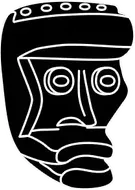The Middle Ages tend to evoke the image of a dark, inactive period in which little of importance happened: a period that we would do well to forget as soon as possible, and that contrasts dramatically with the subsequent Renaissance period in which our current culture is rooted.
Social coarsening
Thanks to works such as The Autumn of the Middle Ages (subtitled: A study of life and thought in the fourteenth and fifteenth centuries in France and the Netherlands), this image shifted as early as 1919. In his book, Huizinga presented a new vision of the 14th and 15th centuries, by contrasting the ongoing social coarsening of this period with its culture of courtly life, thus showing that the late Middle Ages was a period with its own individual character that played an important role in the transition to a new era.
In 1920 Huizinga was awarded the D.A. Thieme Prize for Autumn of the Middle Ages, a prize reserved for a person or organisation that has made an outstanding achievement in or in relation to the Dutch book trade. The Prize is only awarded if there is a suitable candidate. The book appeared in English in 1924 under the titles The Waning of the Middle Ages and The Autumn of the Middle Ages. It also appeared in Swedish (1927), Spanish (1930), French (1932), Hungarian (1937), Italian (1940), Finnish (1951) and Russian (1995).
A feel for language
Johan Huizinga was born in Groningen in 1872. He had a strong feel for language and in his hometown studied German Studies, Sanskrit and comparative linguistics. In 1897 he defended his PhD dissertation on Ancient Indian theatre. After a few years working as a history teacher, Huizinga was appointed Professor of General History, first in Groningen in 1905 and later in Leiden in 1915.
Huizinga was a member of the Royal Netherlands Academy of Arts and Sciences (KNAW) and from 1929 to 1942 he chaired the Academy’s Humanities’ division. He died in Rheden, near Arhnem, in 1945, aged 72, following a short illness. Huizinga is buried in Oegstgeest, in the graveyard of the Little Green Church. His personal and scientific legacy is housed in the Leiden University Library.
Legacy
Huizinga’s legacy is still apparent in the academic world today. At the University of Amsterdam, the Huizinga Institute for Cultural History bears his name. In Leiden, we have the ‘Huizinga Lecture’ cycle, an annual yearly lecture on a cultural historical or cultural philosophical theme that was organised in collaboration with the NRC Handelsblad until 2013, and has since 2014 been organised in collaboration with the magazine Elsevier. Leiden University is also home to the Johan Huizinga Building, which houses the history, art history and classical languages departments, as well as the Leiden University Institute for History. Huizinga’s books and collections continue to be published both in the Netherlands and abroad.

